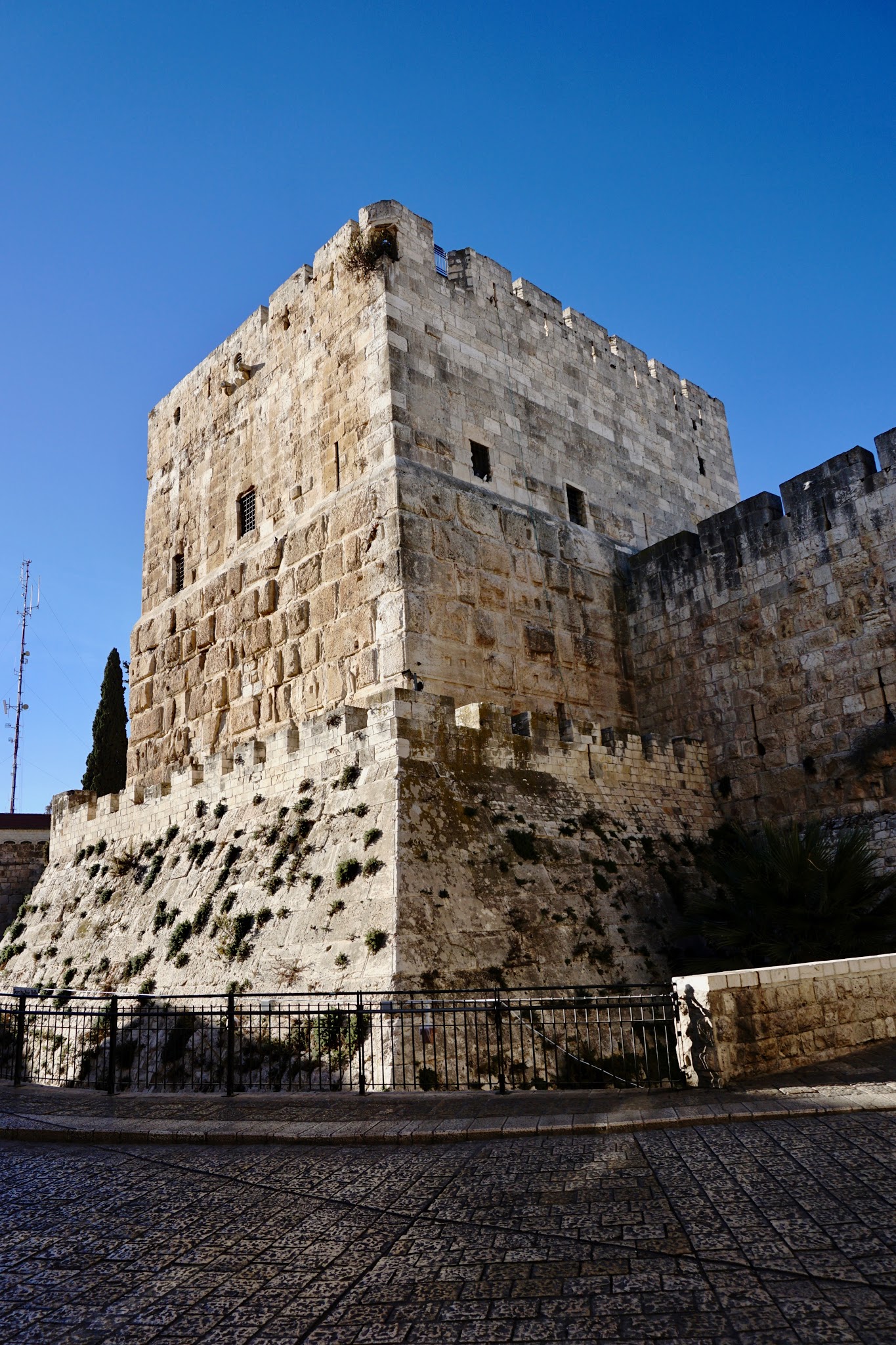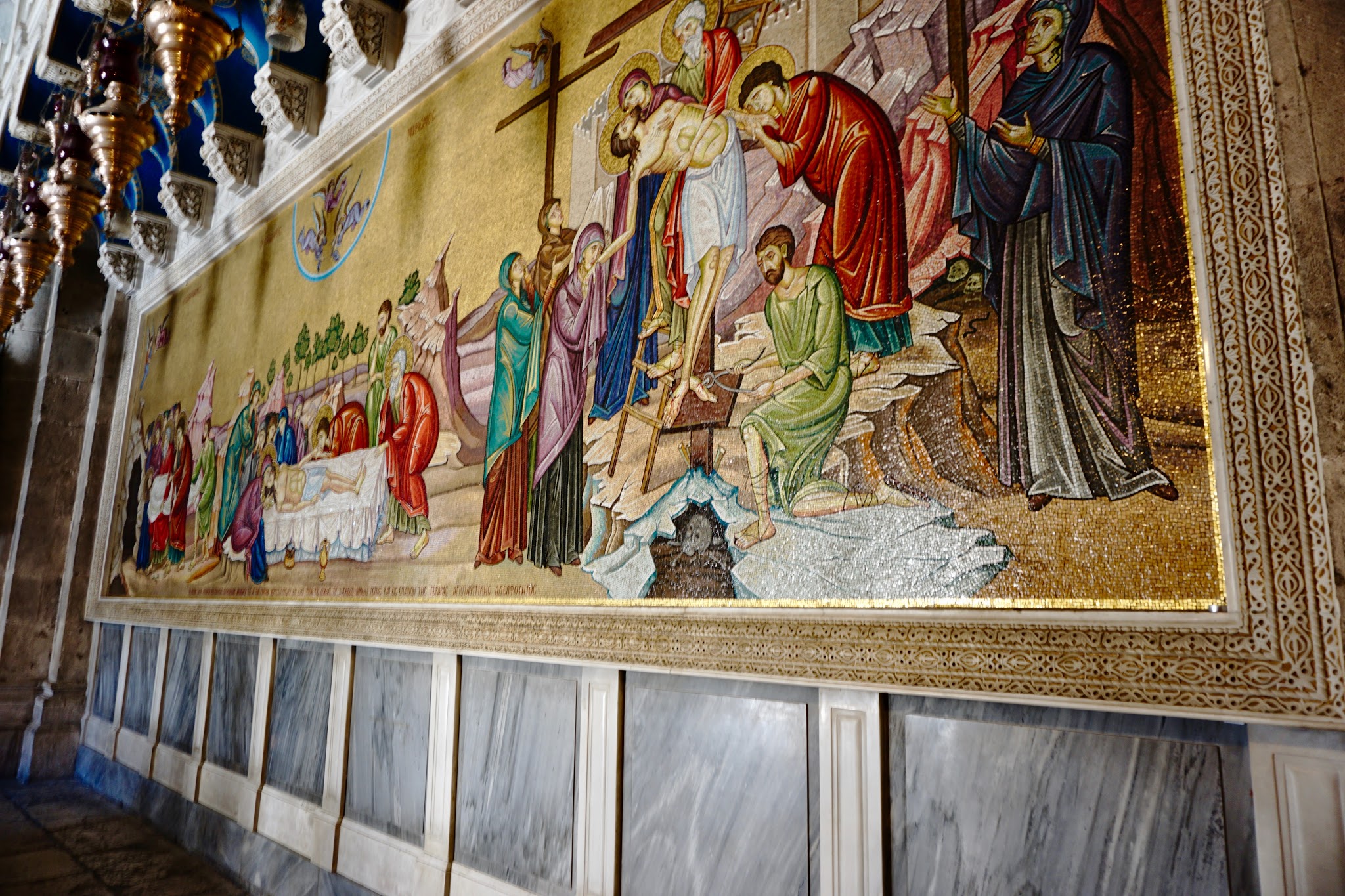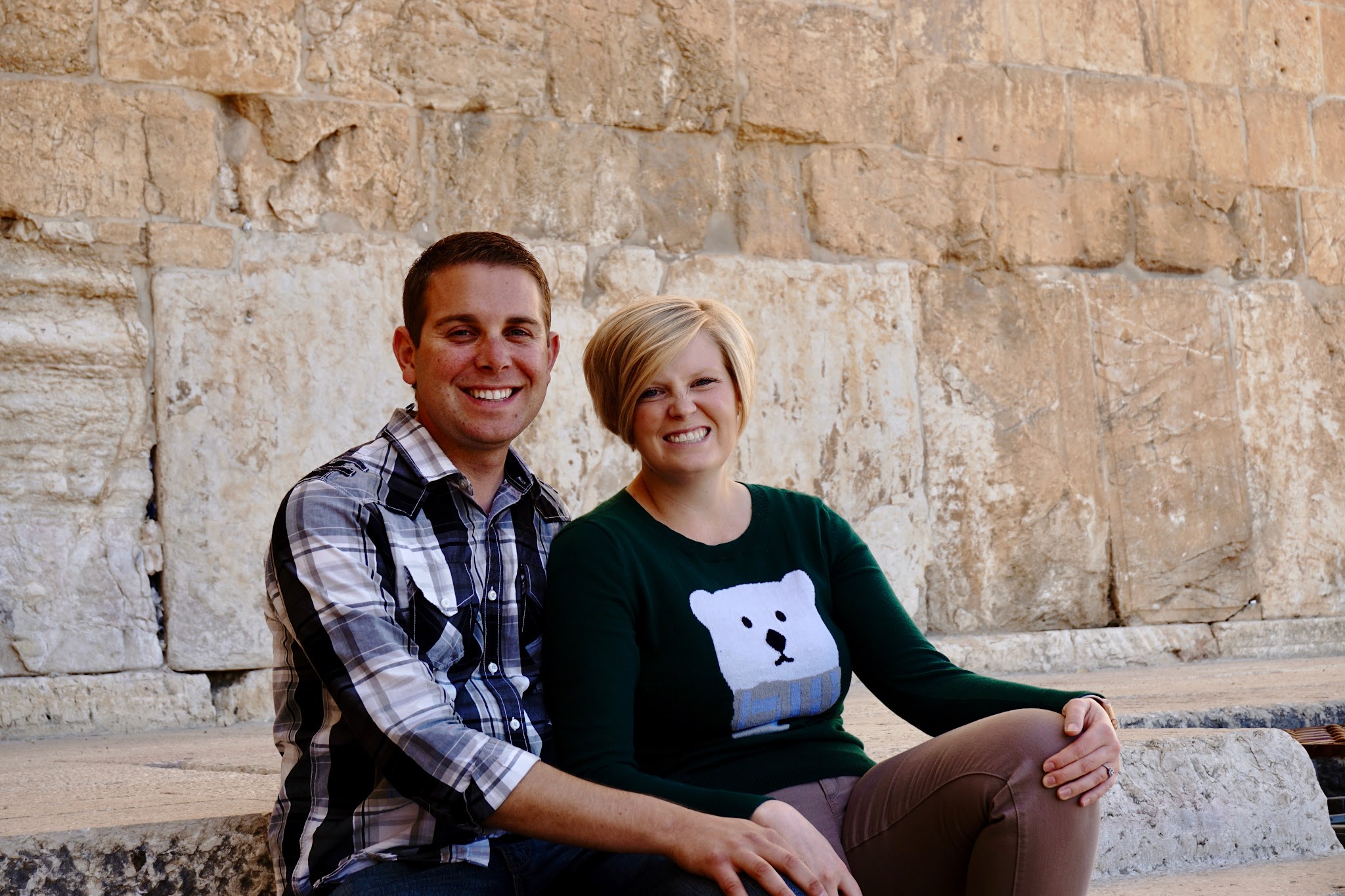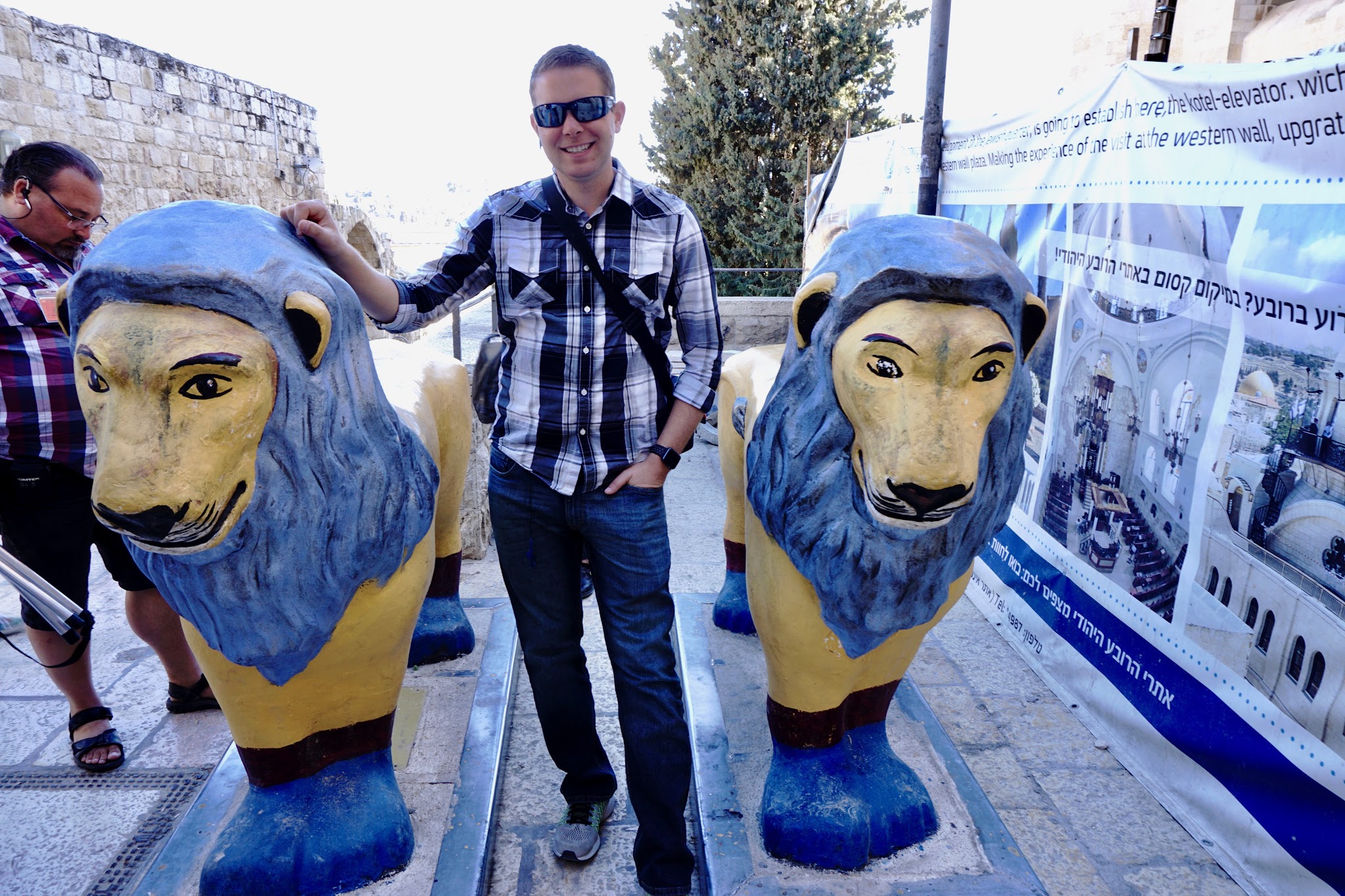Day 13 - The Old City and Shepherd's Fields
Today was another great day in Jerusalem. We stayed close today and started our day with a short bus ride into the Old City. We entered near Jaffa Gate and discussed a few significant items here. First - the walls in Jerusalem were built by Suleiman the Magnificent in the 16th Century. The walls are 3 feet wide and were built to keep invaders out. The walls were built with loopholes, small slits in the walls where defenders could shoot bows and arrows. Additionally, towers were built to ensure that arrows could be shot in every direction. The gates were the weakest parts of the walls, so above the gates, they had places where they could pour boiling oil on their enemies before shooting them with flaming arrows. If invaders managed to get into the gates they had to make a sharp left turn on their horses, which would be challenging while holding their weapons with their right hands. It's fascinating how well fortified the city was.
Inside the gate, we hit the citadel which was a main position for the government. They were also well fortified to protect government officials and keep regular citizens out. This was a normal function of government at the time this was built. The base of the citadel was from King Herod's time. He built three towers and named them after loved ones that he killed. Herod was really bad.
Once we got into Jaffa gate we discussed the significance of this gate. The Kaiser came to Jerusalem to make peace with the Ottoman Empire. To make room for his motorcade, they put a large hole in Jaffa Gate. When the British Empire took control of Palestine following WWI, General Allenby received the official surrender. They arranged a military parade to come through Jaffa Gate with General Allenby on his horse in a very grand military gesture. Once the parade started, Allenby commanded everyone to stop and he got off his horse and walked into the city and received the surrender on foot. When the military asked him why he said it was because pilgrims had been coming to Jerusalem for 1,800 years and he was just another pilgrim.
We headed into the Old City through the Christian Quarter to see the Church of the Holy Sepulcher. This is one of my favorite churches in Jerusalem because it's so eclectic and interesting. The church is owned by 6 different Christian sects and there is a lot of conflict over who owns what section of the church. Cleaning denotes ownership, so there were a lot of areas in the church that hadn't been cleaned for decades. I remembered this from when I came in 2009 and the Edicule for the Tomb was nearly completely black from all the smoke from the candles. In 2014, Pope Francis visited Jerusalem and met with the Archbishop of the Greek Orthodox Church. This was the first time that the leaders from the two religions had met since the Great Schism in 1054. This visit generated enough goodwill that they have begun to clean and make repairs to the church. The section of the church dedicated to Golgotha is undergoing extensive renovations, so the icons are not really visible. However, the ceiling is now two different colors because you can see what has been cleaned. The difference is incredible.
 |
| Outside Jaffa Gate |
 |
| Debbie inspects the defenses of Jerusalem |
 |
| Holes above the gate used to pour hot oil on attacking soldiers |
Inside the gate, we hit the citadel which was a main position for the government. They were also well fortified to protect government officials and keep regular citizens out. This was a normal function of government at the time this was built. The base of the citadel was from King Herod's time. He built three towers and named them after loved ones that he killed. Herod was really bad.
 |
| Herodian stones are visible at the base of this tower |
 |
| King David tower |
Once we got into Jaffa gate we discussed the significance of this gate. The Kaiser came to Jerusalem to make peace with the Ottoman Empire. To make room for his motorcade, they put a large hole in Jaffa Gate. When the British Empire took control of Palestine following WWI, General Allenby received the official surrender. They arranged a military parade to come through Jaffa Gate with General Allenby on his horse in a very grand military gesture. Once the parade started, Allenby commanded everyone to stop and he got off his horse and walked into the city and received the surrender on foot. When the military asked him why he said it was because pilgrims had been coming to Jerusalem for 1,800 years and he was just another pilgrim.
We headed into the Old City through the Christian Quarter to see the Church of the Holy Sepulcher. This is one of my favorite churches in Jerusalem because it's so eclectic and interesting. The church is owned by 6 different Christian sects and there is a lot of conflict over who owns what section of the church. Cleaning denotes ownership, so there were a lot of areas in the church that hadn't been cleaned for decades. I remembered this from when I came in 2009 and the Edicule for the Tomb was nearly completely black from all the smoke from the candles. In 2014, Pope Francis visited Jerusalem and met with the Archbishop of the Greek Orthodox Church. This was the first time that the leaders from the two religions had met since the Great Schism in 1054. This visit generated enough goodwill that they have begun to clean and make repairs to the church. The section of the church dedicated to Golgotha is undergoing extensive renovations, so the icons are not really visible. However, the ceiling is now two different colors because you can see what has been cleaned. The difference is incredible.
 |
| Christian quarter. This is in the morning before most shops are open. It was very quiet. |
 |
| A cat wanders the streets of Jerusalem. Steven described cats as the Kings of Jerusalem |
 |
| A pile of crosses sitting outside the church of the Holy Sepulcher |
 |
| The church of the Holy Sepulcher |
 |
| The stone of unction. Tradition is that this is the spot where Jesus' body was prepared for burial by Joseph of Arimathea. |
 |
| Archways outside the traditional location of Golgotha |
 |
| A mosaic telling the story of the church of the Holy Sepulcher |
 |
| A mosaic telling the story of the church of the Holy Sepulcher. The east end of the church contains Golgotha, the center section contains the stone of unction, and the west has the Aedicule. |
 |
| Dome inside the center of the church of the Holy Sepulcher |
 |
| The Aedicule |
We walked through several different chapels in the Church of the Holy Sepulcher, including the room where the Pope and the Archbishop met 3 years ago. This chapel has tombs next to it, which is the only archaeological evidence that there were tombs in this area. This church became known as the traditional site of the crucifixion and resurrection following Helena's (Constantine's Mother) visit to the Holy Land in the 4th century. She claimed to have found the tomb, so they cut away the mountain around the tomb and built a church on top of it. It's unlikely this is the actual spot, however, since Helena found it 300 years after Christ died and she had alternative objectives for "finding" this site because they were trying to convert everyone to Christianity.
 |
| A candle inside the church of the Holy Sepulcher |
 |
| The church of the Redeemer |
We then went into the Muslim Quarter. 35,000 people live in the Old City where cars can't drive, so there are stands to purchase meat, vegetables, and house supplies in the Old City. We made our way to the Jewish Quarter to see the Cardo. The Cardo was City Center during the Byzantine Empire and is shown on the Madaba Map as the center of the city. There is a cool mural that shows what the Cardo would have looked like anciently, and there is a modern-day child in the painting. It was a really nice artistic touch.
 |
| A butcher shop in the Muslim quarter |
 |
| A painting in the Cardo |
 |
| There were puppies in the Cardo painting. We miss our pup. |
 |
| The Jewish Quarter |
 |
| Alison outside the temple institute |
 |
| A view that never gets old |
After the Cardo, we went to the Western Wall. Jews everywhere read the same passage of the Torah every Monday and Thursday. We got there in the middle of the day to catch some bar mitzvah's happening at the Western Wall. As part of the Bar Mitzvah, the young boy is required to read the passage of the Torah with intonation (the way the Torah is read). Several Bar Mitzvahs were happening at the Western Wall while we were there. The fathers and the sons were on one side, and the mothers and sisters were on the other side standing on chairs so they could see their sons be Bar Mitzvah'd. We found a group of Ethiopian Jews and Stephen asked to participate. They were happy to have us in their group and Steven put the microphone near the boy and he read the Torah. It was awesome. It was really cool to see how excited everyone was and how proud the parents and grandparents were.
 |
| Israeli flag flying over the Western Wall |
 |
| A group of Israeli flags. These flags are everywhere. I like them because they have really simple beauty. |
 |
| The western wall |
 |
| Alison and Debbie look over the barrier between the men's and women's sections of the western wall plaza. |
 |
| Image from a Bar Mitzvah. This family was excited for us to listen in. When our guide, Steven, approached they grabbed the microphone he had and held it close so we could listen in. |
 |
| Our friends Dave and Leslie Ott watching the Bar Mitzvah |
 |
| Image from a Bar Mitzvah. |
 |
| The container used to house the Torah scrolls |
 |
| Image from a Bar Mitzvah. |
Tradition at the Western Wall is that if you put a note on the wall it will go directly to Heaven. Stephen added additional context and said it's similar to the prayer roll in the temple. You can write names on the note and put it on the wall to request an extra blessing for someone. When the Western Wall was taken by the Jews they did a lot of excavation to get it down to a level closer to where it would have been at the time of Herod.
We also talked about Religious Clothing. Orthodox Jews wear their Tallits regularly so they can pray always. Prayer Shawls are made of wool so they can be really warm. Instead, they can purchase Tallit's made of different materials that they wear directly touching their skin under their clothes, similar to the Temple Garment. In fact, the small movie that the church put out about Garments has several scenes at the Western Wall. Some Jews also wear Phylacteries at the Western Wall, and they may not wear them regularly, so they have people at the Wall that can help them put them on and make sure that they are attached correctly and that they say the right things while they are being put on. The temple symbolism is surprisingly similar to Mormon Temples.
After the Western Wall, we ate lunch and then went to the Davidson Archaeological Park. This park is a lot of excavation around the Temple Mount. We discussed where the money changers would have been. Pilgrims needed to change money from their regular currency to the temple currency to pay the half-shekel tax that was required at the temple. They would also need to buy sacrificial animals at the temple because if they traveled with the animals they would have become blemished. The archaeological digs have discovered several ritual immersion fonts around the temple mount where people would have purified themselves before ascending to the temple. One of the most interesting things in this part were stairs that were original from 2,000 years ago. The stairs would have ascended to the top of the temple mount. Archaeologists have added some of the stones, but there are a lot of originals there. This is one of the few spots that we can say for certain that Christ would have walked because we know he ascended to the Temple Mount.
We also talked about Religious Clothing. Orthodox Jews wear their Tallits regularly so they can pray always. Prayer Shawls are made of wool so they can be really warm. Instead, they can purchase Tallit's made of different materials that they wear directly touching their skin under their clothes, similar to the Temple Garment. In fact, the small movie that the church put out about Garments has several scenes at the Western Wall. Some Jews also wear Phylacteries at the Western Wall, and they may not wear them regularly, so they have people at the Wall that can help them put them on and make sure that they are attached correctly and that they say the right things while they are being put on. The temple symbolism is surprisingly similar to Mormon Temples.
After the Western Wall, we ate lunch and then went to the Davidson Archaeological Park. This park is a lot of excavation around the Temple Mount. We discussed where the money changers would have been. Pilgrims needed to change money from their regular currency to the temple currency to pay the half-shekel tax that was required at the temple. They would also need to buy sacrificial animals at the temple because if they traveled with the animals they would have become blemished. The archaeological digs have discovered several ritual immersion fonts around the temple mount where people would have purified themselves before ascending to the temple. One of the most interesting things in this part were stairs that were original from 2,000 years ago. The stairs would have ascended to the top of the temple mount. Archaeologists have added some of the stones, but there are a lot of originals there. This is one of the few spots that we can say for certain that Christ would have walked because we know he ascended to the Temple Mount.
 |
| A reproduction of an old map of Jerusalem showing Jerusalem as the center of the World. |
| A timeline showing key events in the history of Jerusalem |
 |
| Ruins at the Davidson Archeological park next to the temple mount. |
 |
| Ruins at the Davidson Archeological park next to the temple mount. |
 |
| Ruins at the Davidson Archeological park next to the temple mount. In the background a view of the dome of al Aqsa mosque dome is visible. |
 |
| The wall in the archeological park. The ground level at the time the wall was built in the 1500s is clearly visible. |
 |
| Sealed gates in the wall of the temple mount. |
 |
| The archway is a gate that would have been used in the time of Christ. Christ would have used this gate to enter the temple complex. |
 |
| These are steps that would have been used in the time of Christ. Jews who had purified themselves would walk up these steps into the temple complex. |
 |
| View from the steps leading up to the temple mount. |
 |
| View from the steps leading up to the temple mount. |
 |
| The remains of an immersion pool. This would have been used by Jews to cleanse themselves before ascending to the temple. |
After the Davidson Archaeological Park, we headed back to the van and headed to Shepherd's fields near Bethlehem. These are the traditional hills where the shepherds would have received the message of Christ's birth. We read 3 different stories that took place in Bethlehem, each involving women and children. The first story in the Bible that mentions Bethlehem is the story of Rachel. We discussed how Jacob had to flee because he had taken the birthright from Esau at his mother's request. Rebekkah felt as though Jacob should have been the birthright son even though he was the second born. When Esau found out, he was upset and said that he would kill Jacob, so Jacob had to flee. Although Esau took care of his Mother (as the birthright Son would have been responsible to do), Jacob still had the birthright, and from him came the 12 tribes of Israel.
Jacob worked for 14 years to marry Rachel. He worked for 7 years and then her Father gave Jacob her sister Leah because the first sister had to be married first. A week later Jacob married Rachel, but on the agreement that he would stay and work for another 7 years. Rachel was Jacob's favorite and unfortunately, she died in childbirth. She is buried in Bethlehem and oftentimes expects Jewish mothers will visit her grave to receive strength.
The second story regarding Bethlehem is the story of Ruth. Oftentimes, Biblical Authors would change the names of characters in the Bible based on their characteristics. For example, Jezebel means "pile of dung" in Hebrew. Interestingly enough, Naomi means "pleasant" and her two sons' names mean "sickness" and "death." Obviously, Naomi didn't really name her Sons "sickness" and "death", but the Bible Authors changed their names. No one knows what Ruth means, so it's very likely that her name truly was Ruth. Boaz's name means "mighty."
Jacob worked for 14 years to marry Rachel. He worked for 7 years and then her Father gave Jacob her sister Leah because the first sister had to be married first. A week later Jacob married Rachel, but on the agreement that he would stay and work for another 7 years. Rachel was Jacob's favorite and unfortunately, she died in childbirth. She is buried in Bethlehem and oftentimes expects Jewish mothers will visit her grave to receive strength.
The second story regarding Bethlehem is the story of Ruth. Oftentimes, Biblical Authors would change the names of characters in the Bible based on their characteristics. For example, Jezebel means "pile of dung" in Hebrew. Interestingly enough, Naomi means "pleasant" and her two sons' names mean "sickness" and "death." Obviously, Naomi didn't really name her Sons "sickness" and "death", but the Bible Authors changed their names. No one knows what Ruth means, so it's very likely that her name truly was Ruth. Boaz's name means "mighty."
 |
| Reading scriptures in the hills above Bethlehem |
The story of Ruth is a sweet story that takes place during the reign of the Judges. We talked about how if Ruth had returned to her parents, she would have had to forsake God because she was a Moabite, which disliked Jews. She chose to stay with Naomi and worship God. She gleaned the fields of Boaz, and he was very kind to her and took good care of her. Ultimately she ends up marrying Ruth and from this line came David, Solomon, and eventually Jesus.
Finally, we read the story in Luke 2 regarding the Savior's Birth. We talked about how Mary and Joseph came to Bethlehem when Mary was getting close to delivering but probably stayed in Bethlehem for a while until she delivered Jesus. Because of his birth, we can be with our families forever. We sang "Far, Far away on Judea's Plains," but we changed the words to "Near, Near at Hand on Judea's Hills." Judea doesn't even have one Plain, let alone multiple plains. It was a really touching moment in the Day watching the town of Bethlehem from the fields where the Angels sang. We discussed how it's possible that all of us were part of the Heavenly Choir rejoicing with the Shepherds at the Birth of the Savior.
 |
| A shepherd leading his flock of sheep across the hills of Bethlehem |
 |
| Sunset over the town of Bethlehem |
 |
| Bethlehem |
 |
| Sunset over the town of Bethlehem |
We returned to the hotel and Eric and I decided to have a date night in Jerusalem rather than eat dinner with the rest of our group. We took a cab to Ben Yehuda Street. This was an area we came to a lot at night when I was at the Jerusalem Center. There is a large market area with a lot of shops, food, delis, and dessert! We found a cafe for dinner. I had pasta and Eric had pizza. We finished our date with gelato from a place I frequented in 2009. It was such a fun evening enjoying the ambiance and atmosphere of West Jerusalem. It's such a cool city with so much diversity and so much to offer. I'm going to be sad to leave in a few days!
 |
| Delicious pizza |
 |
| Alison's favorite gelato place when she lived at the BYU Jerusalem center |


















Comments
Post a Comment